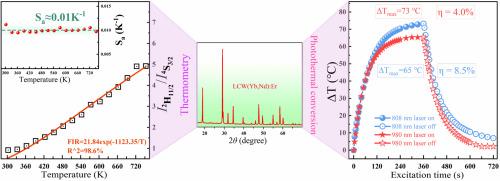Simple synthetic LiCa(Yb,Nd)(WO4)3:Er up-conversion phosphor for photothermal conversion and thermometry applications
IF 5.7
3区 材料科学
Q2 MATERIALS SCIENCE, MULTIDISCIPLINARY
引用次数: 0
Abstract
A bifunctional material LiCa(Yb,Nd)(WO4)3:Er with thermometry and photothermal conversion was synthesized by a simple one-step sintering method. The Nd3+ co-doping not only enriched the UV–vis absorption peak, but also increased the particle layout in the highly excited state 2H11/2 of Er3+. A near-constant sensitivity of 0.01 K-1 was obtained over a wide temperature range (30–480 °C) based on the fluorescence intensity ratio technique of the two thermal-coupled transitions of Er3+ (2H11/2/4S3/2 → 4I15/2). More surprisingly, the sample exhibited excellent photothermal conversion characteristics under near-infrared excitation light. Under 980 or 808 nm excitation, the sample achieved an increase of temperature of 58 °C in 2 min, which is comparable to the core-shell nanostructures synthesized through multi-step complex procedures. Finally, a prototype device was used to demonstrate the feasibility of simultaneous heating and temperature measurement. The above results showed the potential application of the sample as both a thermometer and a photoheater.

用于光热转换和测温应用的简单合成LiCa(Yb,Nd)(WO4)3:Er上转换荧光粉
采用简单的一步烧结法合成了具有测温和光热转换功能的双功能材料LiCa(Yb,Nd)(WO4)3:Er。Nd3+共掺杂不仅丰富了紫外可见吸收峰,而且增加了Er3+在高激发态2H11/2的颗粒布局。基于Er3+ (2H11/2/4S3/2→4I15/2)两个热耦合跃迁的荧光强度比技术,在宽温度范围(30-480℃)内获得了接近恒定的灵敏度0.01 K-1。更令人惊讶的是,样品在近红外激发光下表现出优异的光热转换特性。在980或808 nm激发下,样品在2 min内实现了58℃的温度升高,这与通过多步复杂工艺合成的核壳纳米结构相当。最后,利用原型装置验证了同时加热和测量温度的可行性。上述结果显示了样品作为温度计和光加热器的潜在应用。
本文章由计算机程序翻译,如有差异,请以英文原文为准。
求助全文
约1分钟内获得全文
求助全文
来源期刊

Materials Research Bulletin
工程技术-材料科学:综合
CiteScore
9.80
自引率
5.60%
发文量
372
审稿时长
42 days
期刊介绍:
Materials Research Bulletin is an international journal reporting high-impact research on processing-structure-property relationships in functional materials and nanomaterials with interesting electronic, magnetic, optical, thermal, mechanical or catalytic properties. Papers purely on thermodynamics or theoretical calculations (e.g., density functional theory) do not fall within the scope of the journal unless they also demonstrate a clear link to physical properties. Topics covered include functional materials (e.g., dielectrics, pyroelectrics, piezoelectrics, ferroelectrics, relaxors, thermoelectrics, etc.); electrochemistry and solid-state ionics (e.g., photovoltaics, batteries, sensors, and fuel cells); nanomaterials, graphene, and nanocomposites; luminescence and photocatalysis; crystal-structure and defect-structure analysis; novel electronics; non-crystalline solids; flexible electronics; protein-material interactions; and polymeric ion-exchange membranes.
 求助内容:
求助内容: 应助结果提醒方式:
应助结果提醒方式:


